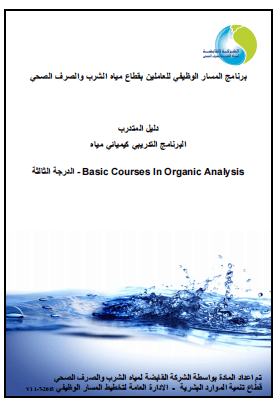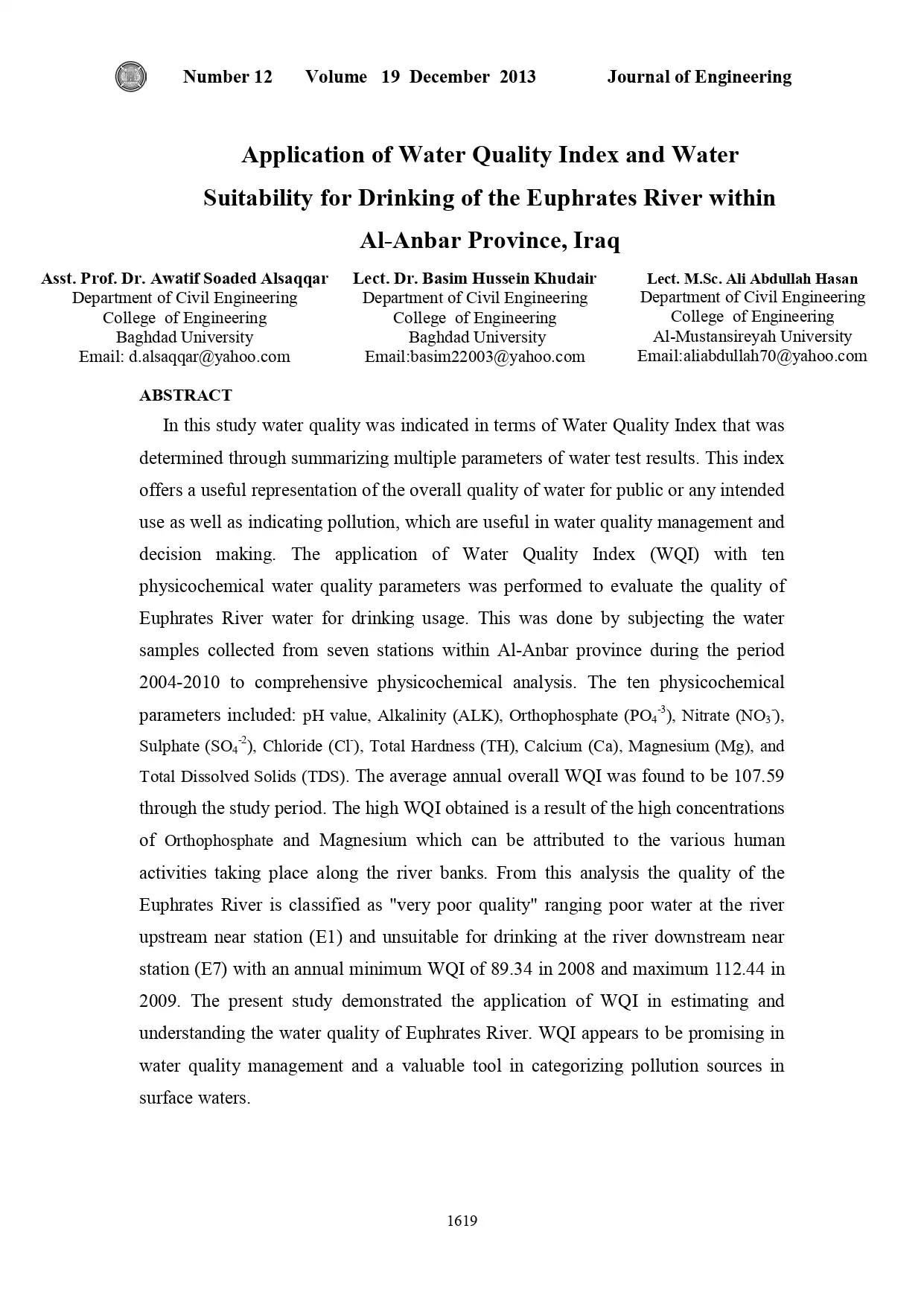Basic Courses In Organic Analysis
Usually dispatched in 2 to 3 days
Usually dispatched in 2 to 3 days
Category:
Drinking Water Treatment
Only logged in customers who have purchased this product may leave a review.
Related products
Analysis of the Membrane Alternatives Suitable for Kvarnagården Water Treatment Plant.
In this study surveys to membrane manufacturers and water treatment plants regarding the performance of different membrane alternatives have been carried out from January to April 2012. The work has been done as a part of a study of the different membrane alternatives suitable for Kvarnagården Water Treatment Plant. Also in the study experiments regarding water quality parameters have been carried out at the water laboratory at Chalmers University of Technology. The project is carried out at the Department of Civil and Environmental Engineering and is connected to the company VIVAB, the company in charge of Kvarnagården Water Treatment Plant.
Analysis of the Membrane Alternatives Suitable for Kvarnagården Water Treatment Plant.
In this study surveys to membrane manufacturers and water treatment plants regarding the performance of different membrane alternatives have been carried out from January to April 2012. The work has been done as a part of a study of the different membrane alternatives suitable for Kvarnagården Water Treatment Plant. Also in the study experiments regarding water quality parameters have been carried out at the water laboratory at Chalmers University of Technology. The project is carried out at the Department of Civil and Environmental Engineering and is connected to the company VIVAB, the company in charge of Kvarnagården Water Treatment Plant.
Application of Water Quality Index and Water Suitability for Drinking of the Euphrates River within Al-Anbar Province, Iraq
In this study water quality was indicated in terms of Water Quality Index that was determined through summarizing multiple parameters of water test results. This index offers a useful representation of the overall quality of water for public or any intended use as well as indicating pollution, which are useful in water quality management and decision making. The application of Water Quality Index (WQI) with ten physicochemical water quality parameters was performed to evaluate the quality of Euphrates River water for drinking usage. This was done by subjecting the water samples collected from seven stations within Al-Anbar province during the period 2004-2010 to comprehensive physicochemical analysis.
Application of Water Quality Index and Water Suitability for Drinking of the Euphrates River within Al-Anbar Province, Iraq
In this study water quality was indicated in terms of Water Quality Index that was determined through summarizing multiple parameters of water test results. This index offers a useful representation of the overall quality of water for public or any intended use as well as indicating pollution, which are useful in water quality management and decision making. The application of Water Quality Index (WQI) with ten physicochemical water quality parameters was performed to evaluate the quality of Euphrates River water for drinking usage. This was done by subjecting the water samples collected from seven stations within Al-Anbar province during the period 2004-2010 to comprehensive physicochemical analysis.
Biological Biofilm Processes
•Used for removal of organic pollutants from wastewaters
•Biological treatment is popular due to:
–low cost
–effective in removal of a wide range of organic contaminants
–effective in removal of colloidal organics
–can remove toxic non-organic pollutants such as heavy metals
Biological Biofilm Processes
•Used for removal of organic pollutants from wastewaters
•Biological treatment is popular due to:
–low cost
–effective in removal of a wide range of organic contaminants
–effective in removal of colloidal organics
–can remove toxic non-organic pollutants such as heavy metals
Activated Carbon Treatment of Drinking Water
Introduction:
Activated carbon filtration (AC) is effective in reducing certain organic chemicals and chlorine in water. It can also reduce the quantity of lead in water although most lead-reducing systems use another filter medium in addition to carbon. Water is passed through granular or block carbon material to reduce toxic compounds as well as harmless taste- and odor-producing chemicals. This fact sheet discusses the principles and processes of typical activated carbon filtration systems.
Activated Carbon Treatment of Drinking Water
Introduction:
Activated carbon filtration (AC) is effective in reducing certain organic chemicals and chlorine in water. It can also reduce the quantity of lead in water although most lead-reducing systems use another filter medium in addition to carbon. Water is passed through granular or block carbon material to reduce toxic compounds as well as harmless taste- and odor-producing chemicals. This fact sheet discusses the principles and processes of typical activated carbon filtration systems.
Advancing Water, Sanitation and Hygiene (WASH) in Panchayats
Access to safe drinking water is critical to survival, and its deprivation could affect the health, food security, and livelihoods of human beings. India achieved 93% coverage of access to improved water supply in rural areas in 2015 towards fulfilling its commitment under the Millennium Development Goal1. However, with reference to safely managed drinking water (improved water supply located on-premises, available when needed and free of contamination) as per Sustainable Development Goal, India still has major targets to achieve, and is geared up to accomplish the same by the end of 2024. With the shift from the Millennium Development Goals (MDGs) to the Sustainable Development Goals (SDGs) less than half of the total rural households in the country have access to safely managed drinking water (improved water supply located on-premises, available when needed and free of contamination).
Advancing Water, Sanitation and Hygiene (WASH) in Panchayats
Access to safe drinking water is critical to survival, and its deprivation could affect the health, food security, and livelihoods of human beings. India achieved 93% coverage of access to improved water supply in rural areas in 2015 towards fulfilling its commitment under the Millennium Development Goal1. However, with reference to safely managed drinking water (improved water supply located on-premises, available when needed and free of contamination) as per Sustainable Development Goal, India still has major targets to achieve, and is geared up to accomplish the same by the end of 2024. With the shift from the Millennium Development Goals (MDGs) to the Sustainable Development Goals (SDGs) less than half of the total rural households in the country have access to safely managed drinking water (improved water supply located on-premises, available when needed and free of contamination).
A Study on the Introduction of Artificial Intelligence Technology in the Water Treatment Process
Today, we stand in front of a huge wave of change named the "Fourth industrial revolution." Key technologies of the Fourth Industrial Revolution include artificial intelligence, the Internet of Thing (IoT), cloud computing, big data analysis, etc. These technologies will lead to an intelligent information society, and platform services will change every aspect of society from economic and work. This paper proposes several introductions of Artificial Intelligence Technology to improve water management.
A Study on the Introduction of Artificial Intelligence Technology in the Water Treatment Process
Today, we stand in front of a huge wave of change named the "Fourth industrial revolution." Key technologies of the Fourth Industrial Revolution include artificial intelligence, the Internet of Thing (IoT), cloud computing, big data analysis, etc. These technologies will lead to an intelligent information society, and platform services will change every aspect of society from economic and work. This paper proposes several introductions of Artificial Intelligence Technology to improve water management.
Recommended Standards for Water Works
A Report of the Water Supply Committee of the Great Lakes--Upper Mississippi River Board
of State and Provincial Public Health and Environmental Managers
Recommended Standards for Water Works
A Report of the Water Supply Committee of the Great Lakes--Upper Mississippi River Board
of State and Provincial Public Health and Environmental Managers
Aerogel & Iron-Oxide Impregnated Granular Activated Carbon Media For Arsenic Removal
The goal of this project is to validate proof-of-concept testing for iron enriched granular activated carbon (GAC) composites (aerogel-GAC or iron-oxide impregnated) as a viable adsorbent for removing arsenic from groundwater and conduct technical and economic feasibility assessments for these innovative processes. Specific project objectives include: • Conduct batch experiments for aerogel-GAC and Fe-oxide impregnated GAC composites to evaluate their performance removing arsenic.
• Evaluate Fe-GAC media performance in rapid small scale column tests (RSSCTs) to assess arsenic removal in a more dynamic treatment system.
• Evaluate Fe-GAC potential for removal of other contaminants (e.g., methyl tertiary butyl ether, dissolved organic carbon).
• Characterize Fe-GAC media.
• Correlate performance and media characterization for possible selection of two media for a future second phase of this project.
Aerogel & Iron-Oxide Impregnated Granular Activated Carbon Media For Arsenic Removal
The goal of this project is to validate proof-of-concept testing for iron enriched granular activated carbon (GAC) composites (aerogel-GAC or iron-oxide impregnated) as a viable adsorbent for removing arsenic from groundwater and conduct technical and economic feasibility assessments for these innovative processes. Specific project objectives include: • Conduct batch experiments for aerogel-GAC and Fe-oxide impregnated GAC composites to evaluate their performance removing arsenic.
• Evaluate Fe-GAC media performance in rapid small scale column tests (RSSCTs) to assess arsenic removal in a more dynamic treatment system.
• Evaluate Fe-GAC potential for removal of other contaminants (e.g., methyl tertiary butyl ether, dissolved organic carbon).
• Characterize Fe-GAC media.
• Correlate performance and media characterization for possible selection of two media for a future second phase of this project.















Reviews
There are no reviews yet.